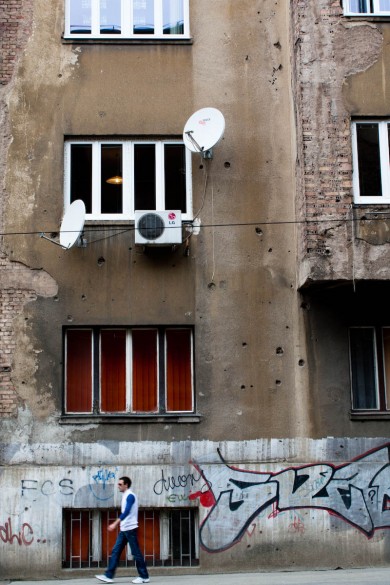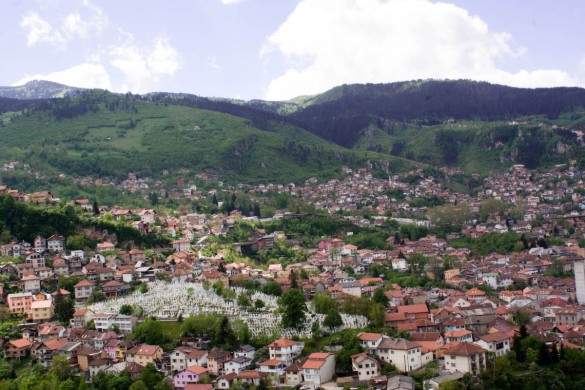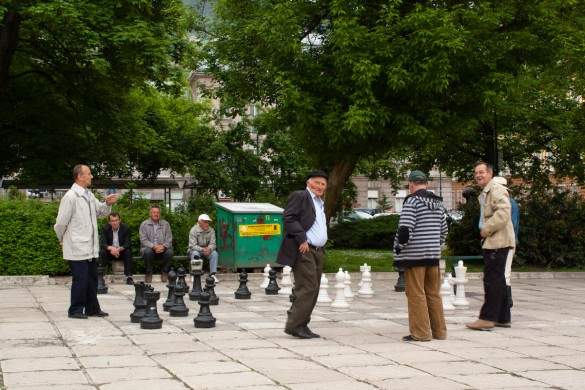If there is one nation that was born for bad luck, it must be Bosnia. Let me give you a short history of the area, just to give you an idea.
We’ll start after the Roman Empire, when the Eurasian Avars conquered most of the Western Balkan. They were said to be very cruel, but probably not that smart, because after little more than hundred years they were defeated by the Serbs and Croats coming from Poland and Czech Republic – or at least from the area where these countries now are. The Serbs took the southeast Balkan, the Croats the west Balkan. With Bosnia i Herzegovina right in between. And if history taught us one thing, it is that you don’t want to be between two superpowers. Time passed by and so did governments, and by the end of the 12th century, BiH had been part of Serbia, Croatia, Bulgaria, Hungary and the Byzantine Empire.
Then things started to get better, the economy flourished, Bosnia became independent and even conquered big pieces of Serbia and Croatia. The future actually looked great for Bosnia, and then came the Turks…Soon the whole Balkan was part of the Ottoman Empire. It must be quite annoying to spend more than 500 years to build an economy with which you can beat your neighbours, eventually conquer them and become a superpower, and then get an unpleasant visit from a super-superpower from somewhere deep south.
Another couple of hundreds of years later, the Russians began to see the threat of the Ottoman empire that close to their borders, so they started to fund a Serbian Croatian revolution after which BiH ended up under the Austrian-Hungarian alliance. Now you must know that during the Ottoman Empire a lot of Bosnians had been sent to Istanbul for army training, and a lot of Turks had been sent to Bosnia for protection. When BiH ended up under the Catholic Austria-Hungarian government, most of the population was Muslim and in favor of the Turkish sultan. Screwed again.
And then Franz Ferdinand got shot, which was the start of World War I. The Austria-Hungarian empire fell apart, the Serbs and Croats got together and built themselves a Yugoslavian Union of Serbia, Croatia and Slovenia. How do you create a union of two countries that are not lying next to each other, one may ask. Good question. Bosnia was not a country anymore, but became part of Croatia or Serbia, depending on whom you’d ask.
Somewhere around 1930 the Union became a Serb dictatorship called “Yugoslavian Kingdom” which blew away the last hope for Muslim independence. The kingdom didn’t last long though, little more that ten years later the Croats found an ally in a little German dictator with a funny mustache and Yugoslavia got divided between Croatia – Croatia and Bosnia – and Germany – almost every other Eastern European country, including Serbia and Slovenia. Just as things couldn’t get worse, the Muslim population of BiH was now part of the fascist Croatia.
After World War I, another dictator came around: Tito. This guy had been a marshal in the Russian army and brought a whole new influence into the region; from now on they were communists. When you live in a country surrounded by superpowers, communism isn’t such a bad thing. Within the new Yugoslavian union, next to Serbia, Croatia and Slovenia also Bosnia was recognized an individual republic and things got slightly better for Bosnia. There were no more civil wars and the economy grew. Until Tito died in 1980.
During the following years, the Russian empire started to fall apart and the Yugoslavian empire soon followed its example. Because of the many changes of government, the Bosnian population was by then divided into three religions: the Muslim, the Catholics and the Orthodox. When both started their own political party, which did not get along with the other two, the country was screwed once again. The Catholics wanted to be part of Croatia, the Orthodox wanted to be part of Serbia and the Muslim wanted a place of their own.

Everyone could see that this would end up in a big disaster, and it did in 1992. Croatia and Slovenia became independent and Bosnia wanted to go the same way. The Serbs did not like that and started one of the dirtiest civil wars in the history of the Balkans. Because one third of the Bosnian population was orthodox – read Serb – it was really a war from within. The Serbs were never able to conquer the centre of Sarajevo, but they were all over the surroundings and cut off every supply of food and water. The people from Sarajevo have been able to keep their city from the Serbs until the United Nations ended the war in 1995. From then Bosnia was finally independent again, even though the country is still divided according to the religions.
Fifteen years after the end of the war, I ended up in Sarajevo. It was one of the cities on my must-see list while travelling through the West Balkans.
One of the first things I noticed was the enormous willpower of the Bosnian people, which they already proved fifteen years ago by keeping a city for three years with no “legal” supplies and constant fear of the snipers in the surrounded hills. And now they proved it to me again. If you look past the bullet holes and cemeteries, the city looks like any other major city in Eastern Europe. The people from Sarajevo left the war behind them and moved on. There are huge new buildings, decent public transport, major European businesses have their offices here, and business people parade the main streets as if they were in Barcelona or Milan. A beer on a terrace costs almost the same as everywhere else in Europe… Now that’s economic improvement. It seems like the war was one hundred years ago.
Walk to the middle of the centre however, the old Ottoman part, and you’re immediately teleported to the 1600s with the old mosques and authentic wooden houses. Don’t look inside unless you plan on buying an overpriced souvenir, but still, it could have been a lot worse.

What fifteen years ago was known as sniper alley is now again the main boulevard of Sarajevo. As the main connection between the airport and the heart of Sarajevo, this was the most important road of the city, but because it’s surrounded by hills, it was an easy target for Serb snipers. This is also the road where you can find the Bosnian Historical Museum (next to the national museum). I have always found it interesting to visit a countries historical museum, to fill the holes in my information. In the first part of the museum you’ll find everything I described before in my short history, from the first until the last but one paragraph.
The second part of the museum was dedicated to the civil war of 1992 – 1995. When visiting other European historical museums, they normally go until right after World War II, which for me – as a generation X/Y – is a far away from my bed show. The documents look old but I don’t see the difference between a piece of paper that is fifty or two hundred years old. To be short, it doesn’t evoke a lot of feelings.
When you enter the part about the civil war in Sarajevo everything feels very real. The pieces of newspaper are not that yellow and the pictures are in colour. This made me realise that it was really not that long ago. I immediately felt an emotional connection between the people on the pictures and myself. I was a teenager during that period, if I was born one thousand kilometres more southeast, it could have been me being shot by snipers.
Visiting the historical museum did change my view on the city. I noticed the bullet and grenade holes better than before and it didn’t take much imagination to picture the old parliament or Holiday Inn as it must have looked like during the war. I really had the feeling that something happened right their, right where I was standing and it freaked me out.

Another place worth visiting is the hill behind the Ottoman quarter. You can get there by following the river until you have the hill on your left and then just by taking the road up. This place gives you a splendid overview of the city. Right in front of you there’s the centre, on your right and left you’ll notice several wide spaces with white crosses. The open wounds of the civil war. When you look behind the city centre, you’ll see sniper alley. You might recognize the old ministry, the Holiday Inn and the new UNITIC Towers, but most of all you’ll see the surrounding hills where the Serbian snipers were waiting for someone to cross the street.

As for most cities, three days is not enough to get to know the place, probably not even enough to get a decent look at the surface. But that does not stop me from trying to imagine how it is and was to be a civilian of Bosnia.
People from Bosnia are not the kind that keeps living from UN supplies and complaining about all the injustice they had gotten during their history. No, certainly not. They stand up, clean their clothes and move on again. They don’t try to run to better places, but rebuild their own place in the hope that faith will be on their side this time, for once. This makes me wonder if you can just heal from your traumas and how you have to do this. Boys and girls in their twenties have seen the most horrible things, how do you get over this? Can you really get over this?